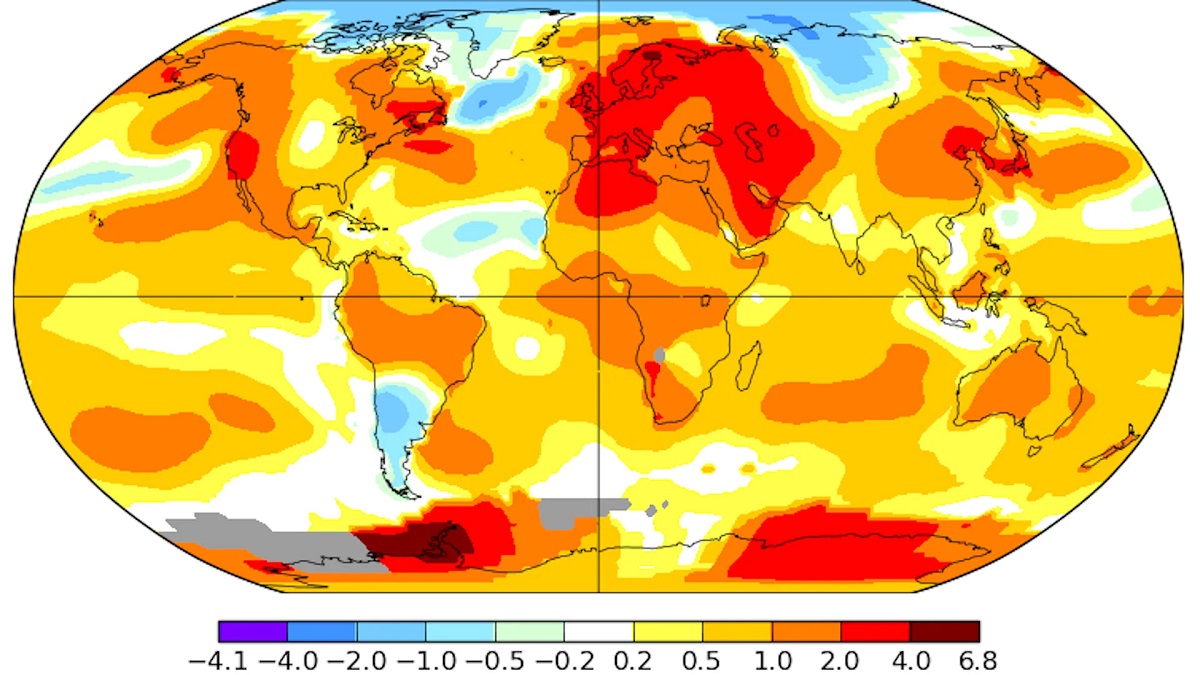Home>Weather and Climate>Global Temperature Map: Explore Temperature Data Worldwide


Weather and Climate
Global Temperature Map: Explore Temperature Data Worldwide
Modified: May 6, 2024
Explore global temperature data and trends with our interactive map. Understand weather and climate patterns worldwide to make informed decisions. Discover temperature variations across different regions.
(Many of the links in this article redirect to a specific reviewed product. Your purchase of these products through affiliate links helps to generate commission for Temperatures.com, at no extra cost. Learn more)
Table of Contents
Introduction
Global temperature mapping plays a pivotal role in understanding the complex dynamics of our planet's climate. It provides valuable insights into the distribution of heat across the Earth's surface, offering a comprehensive view of temperature variations on both regional and global scales. By harnessing advanced technologies and scientific methodologies, researchers and meteorologists can capture, analyze, and visualize temperature data to unravel the intricate patterns that shape our world's climate.
The exploration of global temperature data is not merely an exercise in scientific curiosity; it is a critical endeavor with far-reaching implications for various aspects of human life and the environment. From influencing agricultural practices and shaping urban planning to informing climate change policies and disaster preparedness, the impact of global temperature mapping reverberates across diverse domains.
As we delve into the realm of global temperature mapping, we embark on a journey to comprehend the intricate interplay between atmospheric conditions, oceanic currents, land formations, and human activities. This journey is marked by a quest to decipher the underlying factors driving temperature fluctuations and to discern the subtle yet profound shifts that shape our planet's climate patterns.
In the following sections, we will delve deeper into the methodologies employed to collect and analyze global temperature data, the significance of temperature mapping in addressing environmental challenges, and the practical applications that stem from this invaluable information. Moreover, we will explore the inherent challenges and complexities associated with mapping global temperatures, shedding light on the intricacies of this multifaceted scientific pursuit.
Join us as we embark on an illuminating expedition through the realm of global temperature mapping, unraveling the mysteries of our planet's thermal tapestry and gaining a deeper appreciation for the profound impact of temperature variations on the world we inhabit.
Understanding Global Temperature Data
Global temperature data encompasses a vast array of information that encapsulates the thermal characteristics of the Earth's surface and atmosphere. This data is derived from a multitude of sources, including ground-based weather stations, satellite observations, ocean buoys, and other remote sensing technologies. By assimilating these diverse datasets, scientists and researchers gain a comprehensive understanding of temperature patterns across different geographical regions and temporal scales.
The measurement of global temperatures involves the assessment of both air and surface temperatures, providing a holistic view of thermal dynamics. This comprehensive approach enables the identification of temperature anomalies, seasonal variations, and long-term trends, offering valuable insights into the intricate interplay of climatic factors.
Global temperature data is not confined to a static representation of temperatures at a specific point in time; rather, it encompasses dynamic variations that unfold over days, months, and years. This temporal dimension allows for the analysis of seasonal fluctuations, the identification of climatic trends, and the detection of anomalous temperature spikes or declines.
Moreover, understanding global temperature data entails discerning the spatial distribution of temperatures across the Earth's surface. This spatial perspective unveils the diverse thermal landscapes that characterize different regions, ranging from polar ice caps and arid deserts to lush equatorial rainforests and temperate coastal areas. By examining these spatial variations, scientists can unravel the complex interactions between geographical features, ocean currents, atmospheric circulation, and human influences on temperature patterns.
Furthermore, the integration of advanced modeling techniques and data visualization tools facilitates the elucidation of complex temperature dynamics. Through sophisticated modeling, scientists can simulate and analyze temperature variations under different scenarios, enabling the projection of future climate trends and the assessment of potential impacts on ecosystems, agriculture, and human societies.
In essence, understanding global temperature data transcends mere numerical values; it entails unraveling the intricate tapestry of Earth's thermal patterns, encompassing temporal, spatial, and dynamic dimensions. This multifaceted understanding forms the bedrock for addressing pressing environmental challenges, informing policy decisions, and fostering a deeper appreciation of the profound influence of temperature variations on our planet.
Importance of Global Temperature Mapping
Global temperature mapping holds immense significance in unraveling the intricate dynamics of our planet's climate and its far-reaching implications for various facets of human life and the environment. The importance of this endeavor extends beyond scientific curiosity, permeating diverse domains and influencing critical decision-making processes.
Understanding global temperature patterns is pivotal for comprehending the complex interplay of climatic factors that shape our planet's ecosystems, weather patterns, and natural phenomena. By mapping temperature variations across different geographical regions, researchers and meteorologists can discern the subtle yet profound shifts that influence agricultural practices, urban planning, and environmental conservation efforts.
Moreover, global temperature mapping serves as a cornerstone for addressing pressing environmental challenges, particularly in the context of climate change. By capturing and analyzing temperature data, scientists can identify long-term trends, anomalous fluctuations, and regional disparities, providing crucial insights into the evolving climate patterns. This knowledge forms the basis for formulating effective climate change mitigation strategies, fostering resilience in vulnerable communities, and guiding sustainable resource management practices.
The significance of global temperature mapping also extends to its role in informing policy decisions and international agreements aimed at mitigating climate change and its impacts. Accurate temperature data serves as a fundamental pillar for climate negotiations, enabling policymakers to assess the severity of climate-related risks, allocate resources for adaptation and mitigation measures, and track progress towards global climate goals.
Furthermore, global temperature mapping plays a pivotal role in disaster preparedness and response efforts. By monitoring temperature variations, meteorologists can anticipate extreme weather events, heatwaves, and other climate-related hazards, enabling timely interventions to safeguard lives and infrastructure.
In essence, global temperature mapping is not merely a scientific pursuit; it is a linchpin for fostering resilience, shaping policies, and safeguarding the well-being of present and future generations. By unraveling the intricate tapestry of global temperature patterns, we gain invaluable insights that transcend disciplinary boundaries, empowering us to address environmental challenges and chart a sustainable course for the future.
Methods of Collecting Temperature Data
The collection of temperature data on a global scale encompasses a diverse array of methodologies and technologies, each tailored to capture the complex thermal dynamics of our planet. These methods are instrumental in gathering comprehensive and accurate temperature information, enabling scientists and researchers to unravel the intricate patterns that underpin our planet's climate. Here are some key methods employed in the collection of temperature data:
-
Ground-Based Weather Stations: Traditional weather stations equipped with precise thermometers form the backbone of temperature data collection. These stations are strategically distributed across different geographical regions, providing localized temperature measurements at regular intervals. The data obtained from these stations serves as a foundational source for understanding regional temperature variations and long-term trends.
-
Satellite Observations: Advanced satellite-based remote sensing technologies play a pivotal role in capturing global temperature patterns. Satellites equipped with thermal sensors and radiometers can scan the Earth's surface from space, providing a comprehensive view of temperature distributions across vast expanses. This enables the generation of high-resolution temperature maps and the monitoring of temperature anomalies in remote or inaccessible regions.
-
Ocean Buoys and Floating Platforms: In the context of oceanic temperature monitoring, specialized buoys and floating platforms are deployed across marine environments. These instruments are equipped with sensors that measure sea surface temperatures, offering valuable insights into oceanic thermal dynamics. By assimilating data from these oceanic monitoring systems, scientists can gain a deeper understanding of ocean-atmosphere interactions and their influence on global climate patterns.
-
Remote Sensing Technologies: In addition to satellites, a myriad of remote sensing technologies, such as LiDAR (Light Detection and Ranging) and infrared thermography, are employed to capture temperature data across diverse landscapes. These technologies enable the non-invasive measurement of surface temperatures in various ecosystems, ranging from dense forests and urban areas to arid deserts and polar regions.
-
Weather Balloons and Radiosondes: Weather balloons equipped with radiosondes, which are instruments that transmit atmospheric data, are deployed to capture vertical temperature profiles in the Earth's atmosphere. These high-altitude measurements provide crucial insights into atmospheric temperature variations, aiding in the understanding of atmospheric stability, weather patterns, and climate dynamics.
By harnessing these diverse methodologies, scientists and meteorologists can compile a comprehensive dataset of global temperature information, encompassing spatial, temporal, and vertical dimensions. The integration of data from these varied sources facilitates the generation of accurate temperature models, the identification of climate trends, and the assessment of temperature impacts on ecosystems and human societies.
In essence, the methods of collecting temperature data represent a convergence of cutting-edge technologies and scientific ingenuity, enabling us to unravel the thermal tapestry of our planet and gain a deeper appreciation for the intricate interplay of climatic factors.
Analyzing Global Temperature Trends
Analyzing global temperature trends entails a meticulous examination of historical temperature data to discern patterns, anomalies, and long-term shifts in the Earth's thermal dynamics. This process involves the application of advanced statistical methods, data visualization techniques, and climate modeling to extract meaningful insights from the wealth of temperature information at our disposal.
One of the primary objectives of analyzing global temperature trends is to identify overarching patterns that transcend regional variations. By aggregating and synthesizing temperature data from diverse sources, researchers can discern global-scale trends, such as overall temperature increases or shifts in the frequency and intensity of extreme weather events. This macroscopic perspective is crucial for understanding the overarching trajectory of global climate change and its implications for ecosystems, agriculture, and human societies.
Moreover, the analysis of global temperature trends encompasses the identification of spatial disparities in temperature variations. By scrutinizing temperature data across different geographical regions, scientists can pinpoint areas experiencing disproportionate warming or cooling trends, shedding light on localized climate dynamics. This spatial granularity is instrumental for tailoring region-specific adaptation strategies and understanding the differential impacts of climate change on vulnerable communities.
Furthermore, the analysis of global temperature trends extends to the exploration of temporal patterns, including seasonal fluctuations and long-term climate oscillations. By dissecting temporal temperature data, researchers can unravel the intricate interplay of natural climate cycles, such as El Niño and La Niña phenomena, and discern their influence on global temperature trends. This temporal lens enables the identification of cyclical patterns and the projection of future climate scenarios, aiding in climate modeling and predictive assessments.
Additionally, the analysis of global temperature trends involves the detection of anomalous temperature spikes, abrupt shifts, or sustained deviations from historical norms. These anomalies serve as critical indicators of climate variability and can signal the emergence of unprecedented temperature patterns. By scrutinizing these anomalies, scientists can glean insights into the complex drivers of temperature fluctuations, including anthropogenic influences and natural climatic processes.
In essence, analyzing global temperature trends is a multifaceted endeavor that transcends numerical data analysis; it embodies a quest to unravel the intricate thermal tapestry of our planet, discern the subtle yet profound shifts in climate dynamics, and glean insights that inform climate resilience and sustainable adaptation strategies.
Read more: Global Temperature Trends
Applications of Global Temperature Mapping
Global temperature mapping serves as a cornerstone for a myriad of practical applications that extend across diverse domains, influencing critical decision-making processes and fostering resilience in the face of environmental challenges. The insights gleaned from temperature mapping initiatives are instrumental in shaping policies, guiding resource management practices, and empowering communities to adapt to changing climate dynamics.
One of the foremost applications of global temperature mapping lies in its pivotal role in informing agricultural practices and land management strategies. By delineating temperature variations across different regions, farmers and land managers can make informed decisions regarding crop selection, planting schedules, and irrigation practices. Moreover, temperature mapping aids in assessing the suitability of specific regions for agricultural activities, guiding land-use planning and fostering sustainable agricultural practices.
Furthermore, global temperature mapping plays a crucial role in urban planning and infrastructure development. By understanding temperature variations in urban areas, city planners can devise strategies to mitigate urban heat island effects, optimize energy usage, and enhance the livability of urban environments. Temperature mapping also informs the design of resilient infrastructure that can withstand temperature extremes and climate-related hazards, fostering sustainable urban development.
In the realm of public health, global temperature mapping contributes to the assessment of heat-related health risks and the formulation of targeted interventions to protect vulnerable populations. By identifying regions experiencing extreme heat events, public health authorities can implement heatwave preparedness measures, disseminate early warning systems, and allocate resources to mitigate the health impacts of high temperatures.
Moreover, global temperature mapping serves as a linchpin for climate change adaptation and mitigation efforts. By capturing temperature data, policymakers and climate scientists can assess the severity of climate-related risks, develop adaptation strategies, and monitor the effectiveness of mitigation measures. Temperature mapping also underpins international climate agreements, providing the empirical basis for setting climate targets and tracking progress towards global climate goals.
In essence, the applications of global temperature mapping permeate diverse sectors, ranging from agriculture and urban planning to public health and climate resilience. By harnessing the insights derived from temperature mapping initiatives, we can foster sustainable development, safeguard human well-being, and chart a resilient course in the face of a changing climate.
Challenges in Global Temperature Mapping
The pursuit of global temperature mapping is not devoid of challenges; it is fraught with complexities that stem from the dynamic nature of Earth's climate and the intricacies of temperature data collection and analysis. These challenges underscore the multifaceted nature of temperature mapping and the need for innovative solutions to surmount them.
One of the primary challenges in global temperature mapping lies in ensuring comprehensive spatial coverage. While ground-based weather stations and satellite observations provide valuable temperature data, there are regions, such as remote wilderness areas and polar regions, where obtaining accurate temperature measurements poses significant logistical challenges. Overcoming these spatial coverage limitations requires the deployment of advanced remote sensing technologies and the establishment of collaborative international initiatives to capture temperature data from geographically diverse landscapes.
Furthermore, the integration of disparate temperature datasets from various sources presents a formidable challenge. Harmonizing data obtained from ground-based stations, ocean buoys, satellites, and remote sensing technologies necessitates the development of robust data assimilation techniques and quality control protocols. Ensuring the accuracy and consistency of integrated temperature datasets is paramount for generating reliable climate models and facilitating cross-disciplinary research endeavors.
Another significant challenge in global temperature mapping pertains to the detection and mitigation of measurement biases and uncertainties. Factors such as changes in measurement instruments, urbanization effects, and land use modifications can introduce biases into temperature datasets, complicating the interpretation of long-term temperature trends. Addressing these biases requires meticulous data validation procedures, statistical adjustments, and the implementation of standardized measurement protocols to minimize uncertainties in temperature records.
Moreover, the dynamic nature of Earth's climate introduces complexities in discerning natural climate variability from anthropogenic influences. Distinguishing between natural temperature oscillations and human-induced climate change signals demands advanced climate modeling capabilities and the integration of multi-disciplinary research approaches. Unraveling these complexities is essential for accurately attributing temperature trends to specific climatic drivers and informing evidence-based climate policies.
In essence, the challenges in global temperature mapping underscore the need for concerted efforts to enhance spatial coverage, harmonize diverse datasets, mitigate measurement biases, and disentangle natural and anthropogenic climate signals. By addressing these challenges, we can fortify the foundation of global temperature mapping, fostering a deeper understanding of Earth's climate dynamics and empowering informed decision-making in the face of a changing climate.
Conclusion
In conclusion, the exploration of global temperature mapping unveils a profound tapestry of Earth's thermal dynamics, encompassing spatial, temporal, and dynamic dimensions. The significance of this endeavor extends far beyond scientific curiosity, permeating diverse domains and influencing critical decision-making processes. By unraveling the intricate patterns of temperature variations across the planet, we gain invaluable insights that transcend disciplinary boundaries, empowering us to address environmental challenges and chart a sustainable course for the future.
The multifaceted understanding of global temperature data serves as a linchpin for fostering resilience, shaping policies, and safeguarding the well-being of present and future generations. From informing agricultural practices and urban planning to guiding climate change policies and disaster preparedness, the impact of global temperature mapping reverberates across various facets of human life and the environment. It is pivotal for comprehending the complex interplay of climatic factors that shape our planet's ecosystems, weather patterns, and natural phenomena.
The methodologies employed in collecting temperature data, including ground-based weather stations, satellite observations, ocean buoys, and remote sensing technologies, converge to capture the complex thermal dynamics of our planet. By assimilating data from these varied sources, scientists and meteorologists compile a comprehensive dataset of global temperature information, enabling the generation of accurate temperature models and the assessment of temperature impacts on ecosystems and human societies.
Furthermore, the analysis of global temperature trends entails a meticulous examination of historical temperature data to discern patterns, anomalies, and long-term shifts in the Earth's thermal dynamics. This process involves the application of advanced statistical methods, data visualization techniques, and climate modeling to extract meaningful insights from the wealth of temperature information at our disposal.
The applications of global temperature mapping permeate diverse sectors, ranging from agriculture and urban planning to public health and climate resilience. By harnessing the insights derived from temperature mapping initiatives, we can foster sustainable development, safeguard human well-being, and chart a resilient course in the face of a changing climate.
Despite the challenges inherent in global temperature mapping, including spatial coverage limitations, data integration complexities, and measurement biases, the pursuit of unraveling Earth's thermal tapestry remains paramount. By addressing these challenges, we can fortify the foundation of global temperature mapping, fostering a deeper understanding of Earth's climate dynamics and empowering informed decision-making in the face of a changing climate.
In essence, global temperature mapping serves as a beacon of knowledge, illuminating the intricate interplay of climate dynamics and guiding us towards a future where the resilience of ecosystems, the well-being of communities, and the sustainability of our planet are safeguarded.














